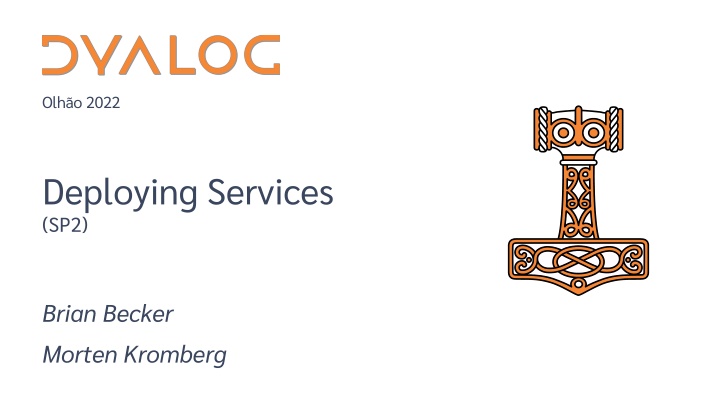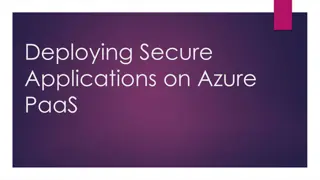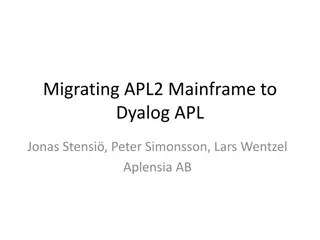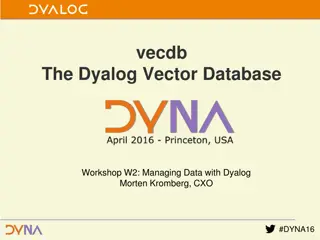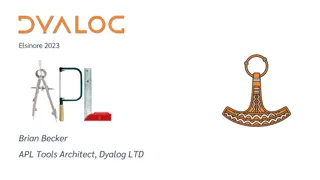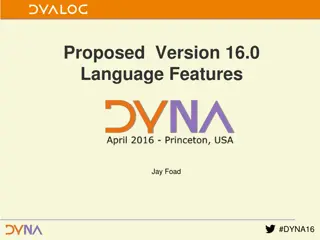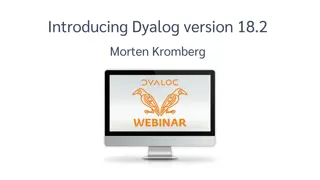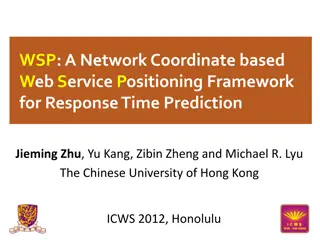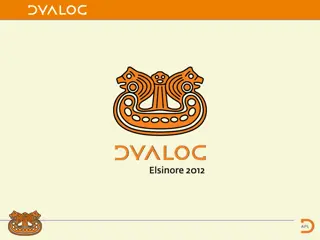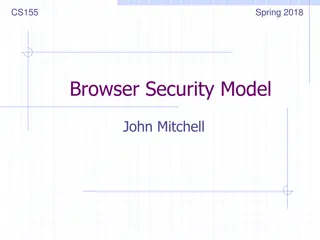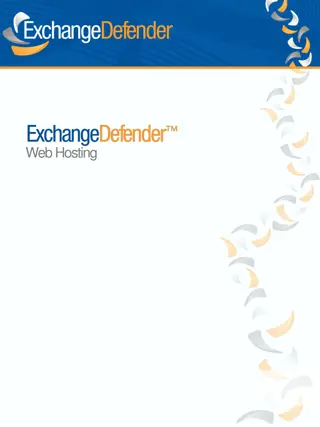Olho 2022 Deploying Services - Jarvis Dyalog's Web Service Framework
Give a quick introduction to Jarvis Dyalog's Web Service Framework for exposing APL functions as services using Docker to create lightweight virtual machines known as "Containers". Learn about Docker Compose for managing inter-connected containers, Amazon Web Services Elastic Container Service for serverless deployment, scaling the system, assigning domain names, and certificates to services.
Download Presentation

Please find below an Image/Link to download the presentation.
The content on the website is provided AS IS for your information and personal use only. It may not be sold, licensed, or shared on other websites without obtaining consent from the author.If you encounter any issues during the download, it is possible that the publisher has removed the file from their server.
You are allowed to download the files provided on this website for personal or commercial use, subject to the condition that they are used lawfully. All files are the property of their respective owners.
The content on the website is provided AS IS for your information and personal use only. It may not be sold, licensed, or shared on other websites without obtaining consent from the author.
E N D
Presentation Transcript
Olho 2022 Deploying Services (SP2) Brian Becker Morten Kromberg
Goals Give a quick introduction to: Jarvis Dyalog's Web Service Framework to expose APL functions as services Docker: to create lightweight Virtual Machines known as "Containers" Docker Compose: to launch and manage multiple inter-connected containers Amazon Web Services "Elastic Container Service": to allow Docker Compose to launch containers directly to the cloud (so-called "serverless" deployment) How to scale the system by running multiple copies of selected services How to assign your own domain name and a certificate to your service Deploying Services 1
Disclaimer This workshop covers a lot of material with which we expect most of you will be somewhat unfamiliar. (we learned a lot ourselves in preparing the material Our intent is to show what is possible and roughly how complicated it is. Work together through the exercises and don't be afraid to ask questions. The workshop materials contain a working system which you can continue to work with when you get home. We plan to follow up with a series of webcasts that will present the material in more "bite-sized" chunks. We expect the examples and configuration files will continue to evolve and updates will be available on GitHub. You are welcome to contact us after Dyalog'22 for some free assistance. ) Deploying Services 2
The Plan 14:00-15:00 Setting the Scene Introduction to Jarvis, Docker and the "Phonebook Service" Limbering up: running and calling the Service from APL Building and launching a local Docker container 15:15-16:15 Cloud Storage Creating a two-tier application in preparation for scaling the system Introduction to "docker compose" Building, launching and debugging the two-tier solution 16:30-17:30 Scalable Execution on the Cloud Installing the Amazon Command Line Interface (CLI) Launching the application on "Serverless" Amazon Fargate Wrap up: Using your own domain, and adding a certificate (or not) Deploying Services 3
The Plan Visualized Deploying Services 4
The Plan Visualized In the beginning, there was an Application Database App Deploying Services 5
Run the app as a service Database Jarvis App Deploying Services 6
Run it in a container Database Docker Container Jarvis App Deploying Services 7
Split into Front and Back Ends We'll call this "Two-Tier" Front End Database Read Operations Write Operations Back End Deploying Services 8
Try it in the cloud "The Cloud" (AWS) Database Read Operations Write Operations Deploying Services 9
Scale it up "The Cloud" (AWS) Database Read Operations Write Operations Deploying Services 10
Load balance it "The Cloud" (AWS) Database Read Operations Load Balancer Write Operations Deploying Services 11
Secure it "The Cloud" (AWS) Database Read Operations Load Balancer Write Operations Deploying Services 12
Check List Have You Installed Docker? Installed Jarvis? Downloaded Workshop Materials? Signed up for an AWS account? It should cost less than one $/ to do all the exercises Around $20 / month if you leave it running Installed & Configured the AWS Command Line Interface? How many of you have a domain under your control? How many of you are on a non-Windows platform? Apologies, all our automation uses .BAT files (But real hackers like adapting and running scripts ) Deploying Services 13
Introducing Jarvis APL-based web service framework (JSON and REST Service) Today we'll be using the JSON paradigm Service "endpoints" are result-returning monadic or dyadic APL functions All requests are HTTP POST, all payloads are JSON Jarvis handles the conversion between JSON to APL and back again Deploying Services 15
Exercise 0 A Web Service in 5 Minutes NOTE: All examples assume ( IO ML) 1 [SP2] is the folder with the SP2 workshop materials Start a Dyalog session ]load [SP2]/Jarvis sum +/ reverse Server Jarvis.Run 8083 # ]open http://localhost:8083 Hint: Try [1,2,3,4,5] as input data Deploying Services 16
The Phonebook Application The database Two tables users and phonebook Stored in .json files (a real app would likely use a DBMS) Users can edit both tables Phonebook entry "owners" can edit their own entry Anyone can read entries Deploying Services 17
Run the app as a service Database Jarvis App Deploying Services 18
Exercise 1 Test the Phonebook Application [SP2] is the folder with the SP2 workshop materials Start a Dyalog session ]load [SP2]/Jarvis Server Jarvis.New '[SP2]/single-tier/app/jarvis.json' Server.Start Start another Dyalog ]load [SP2]/single-tier/HttpCommand HttpCommand.Version should be 5.1.5 or later cmd HttpCommand.New 'post' 'localhost:8080/GetUsers' '""' cmd.Show resp cmd.Run resp.Data resp HttpCommand.GetJSON 'post' 'localhost:8080/GetUsers' '' JSON resp.Data.payload ]open http://localhost:8080 Deploying Services 19
Introduction to Docker The most widely used container technology are "docker" containers From: http://www.zdnet.com/article/what-is-docker-and-why-is-it-so-darn-popular/ Deploying Services 20
Efficient and Simple The really stunning thing is that Docker Containers have a very simple text based description of the contents of a container ... and they start in seconds (at least if they are Linux-based) Deploying Services 21
A "Dockerfile" describes the Container Base Image FROM ubuntu:22.04 ADD ./dyalog-unicode_18.2.nnnnn_amd64.deb / ADD /myapp/v7/test /myapp Files to Add Your Code RUN dpkg -i /dyalog*.deb RUN git clone https://github.com/dyalog/Jarvis /Jarvis Run during Build Environment Vars ENV RIDE_INIT="SERVE:*:4502" ENV CodeLocation=/myapp Run at Startup CMD dyalog /Jarvis/Distribution/jarvis.dws This "Dockerfile" completely describes a machine which will run "myapp". Deploying Services 22
Building and Running the Docker Image Dockerfile FROM ubuntu:22.04 ADD ./dyalog-unicode_18.2.nnnnn_amd64.deb / ADD /myapp/v7/test /myapp RUN dpkg -i /dyalog*.deb RUN git clone https://github.com/dyalog/Jarvis /Jarvis ENV RIDE_INIT="SERVE:*:4502" ENV CodeLocation=/myapp CMD dyalog /Jarvis/Distribution/jarvis.dws Build docker build t myco/myapp-test . Run docker run -p 8081:8080 -v /somefolder:/data e DEBUG=1 myco/myapp-test Deploying Services 23
docker run syntax & common switches docker run [OPTIONS] IMAGE [COMMAND] [ARG...] docker run -p 8081:8080 -v /somefolder:/data e DEBUG=1 myco/myapp-test Switch -p hhhh:cccc Description Make TCP port cccc in container visible on the host as hhhh Set environment variable inside the container Mount /hfolder in container as /cfolder NB Under Windows, /hfolder must be a full pathname using Windows conventions (C:\...) Discard changes when container terminates -e name=value -v /hfolder:/cfolder --rm Deploying Services 24
Container Distribution DockerHub is to Docker as GitHub is to Git A public repository of container images Unlimited public images for free You can store one free private image You can install private servers "in house" Today, we will use Amazon Elastic Container Registry ECR is a repository integrated with Amazon Web Services o Deploying Services 25
Distributing the Image via DockerHub Build docker build t myco/myapp-test . We can "push" the image to DockerHub: You need an account Push docker login docker push myco/myapp-test Now, the following will work on ANY computer that has Docker installed (no explicit "docker pull" is required) Run docker run -p 8081:8080 -v /somefolder:/data e DEBUG=1 myco/myapp-test Deploying Services 26
Public Dyalog Images Image Description Just Dyalog APL Dyalog APL + Jarvis Dyalog APL + MiServer Dyalog APL + Jupyter Notebook framework dyalog/dyalog dyalog/jarvis dyalog/miserver dyalog/jupyter NB all public images assume/provide you have a basic Dyalog licence. docker run -p 8081:8080 -v /my/web/service:/app dyalog/jarvis Deploying Services 27
Typical Switches settings when using public Dyalog Images Description Expose default Jarvis/MiServer port as port 80 Enable "Zero Footprint" RIDE on port 8088 Expose port 8088 to the outside world Mount /my/web/service in container as /app Switch -p 80:8080 -e RIDE_INIT=HTTP:*:8088 -p 8088:8088 -v /my/web/service:/app docker run -p 8081:8080 -v /somefolder:/app dyalog/jarvis:latest Deploying Services 32
Benefits of Public Containers Without Public Containers FROM ubuntu:22.04 ADD ./dyalog-unicode_18.2.nnnnn_amd64.deb / RUN dpkg -i /dyalog*.deb RUN git clone https://github.com/dyalog/Jarvis /Jarvis ADD /myapp/v7/test /app CMD dyalog /Jarvis/Distribution/jarvis.dws With Public Containers FROM dyalog/jarvis ADD /myapp/v7/test /app Or without building a container at all docker run p 8080:8080 v /myapp/v7/test:/app dyalog/jarvis Deploying Services 33
Warning: Public Containers The public containers are for experimentation and prototyping For production use, you should build your own container Otherwise, the version of the interpreter or Jarvis might change under your feet Deploying Services 34
Run it in a container Database Docker Container Jarvis App Deploying Services 35
Exercise 2 Running Phonebook in Docker Start Docker / Docker Desktop Build & start docker container Make a request Debug with RIDE Hint: See build.bat and start-local.bat in the single-tier folder Deploying Services 38
Putting a stop to things using Docker Desktop Deploying Services 39
Split into Front and Back Ends We'll call this "Two-Tier" Front End Database Read Operations Write Operations Back End Deploying Services 44
Two-Tier Phonebook Front-End Read-only endpoints read directly from database Requests for endpoints that write to the database are relayed to the Back-End All authentication and validation of payloads is done in the front end Back-End Endpoints do no authentication or payload validation All endpoints return an namespace with rc return code: 0 means "no error" msg informational message if applicable payload response payload, if any Deploying Services 45
respreq AddUser ns;user;rc;msg;users [1] end 0 (resp ns utils.checkPayload'"login' '"password').rc [2] resp utils.initializeResponse [3] [4] :Hold 'database' [5] :If 0 (rc msg users) dbapi.readUsers [6] end resp.(rc msg) rc msg [7] :EndIf [8] [9] :If 0 users.login utils.indexOf ,ns.login [10] fail resp.(rc msg) 400('user ',ns.login,' already exists') [11] :EndIf [12] [13] ns.password utils.hashPassword ns.password [14] ns.updatedAt utils.now [15] users, ns [16] end 0 (resp dbapi.writeUsers users).rc [17] [18] resp.(rc msg) 0('user ',ns.login,' added') [19] :EndHold [20] 0 [21] end: [22] :If 0 resp.rc req.Fail resp.rc :EndIf Single-Tier Deploying Services 46
respreq AddUser ns;user;rc;msg;users [1] end 0 (resp ns utils.checkPayload'"login' '"password').rc [2] resp req utils.callBackEnd ns [3] end: [4] :If 0 resp.rc req.Fail resp.rc :EndIf Two-Tier Front End Deploying Services 47
respreq AddUser ns;user;rc;msg;users [1] end 0 (resp ns utils.checkPayload'"login' '"password').rc [2] resp req utils.callBackEnd ns [3] end: [4] :If 0 resp.rc req.Fail resp.rc :EndIf Two-Tier Front End resp req callBackEnd ns;r [1] sends a call to the backend endpoint [2] :Trap 0 [3] r HttpCommand.GetJSON'post'('backend:8081',req.Endpoint)ns [4] :If r.rc=0 [5] :AndIf r.HttpStatus=200 [6] resp r.Data [7] 0 [8] :EndIf [9] :EndTrap [10] resp initializeResponse [11] resp.(rc msg) 500('back end call failed') [12] req.Fail 500 Deploying Services 48
respreq AddUser ns;user;rc;msg;users [1] end 0 (resp ns utils.checkPayload'"login' '"password').rc [2] resp req utils.callBackEnd ns [3] end: [4] :If 0 resp.rc req.Fail resp.rc :EndIf Two-Tier Back End Front End resp req AddUser ns;user;rc;msg;users [1] resp utils.initializeResponse [2] [3] :Hold 'database' [4] :If 0 (rc msg users) dbapi.readUsers [5] end resp.(rc msg) rc msg [6] :EndIf [7] [8] :If 0 users.login utils.indexOf ,ns.login [9] fail resp.(rc msg) 400('user ',ns.login,' already exists') [10] :EndIf [11] [12] ns.password utils.hashPassword ns.password [13] ns.updatedAt utils.now [14] users, ns [15] end 0 (resp dbapi.writeUsers users).rc [16] [17] resp.(rc msg) 0('user ',ns.login,' added') [18] :EndHold [19] 0 [20] end: [21] :If 0 resp.rc req.Fail resp.rc :EndIf Deploying Services 49
